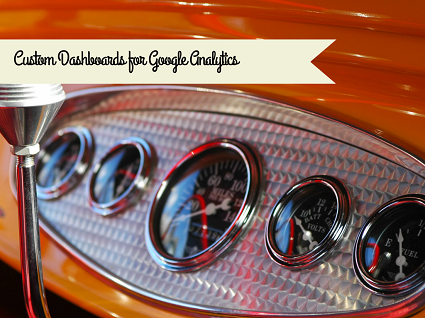Custom dashboards in your website analytics allow you to get a quick view of how you’re doing on specific metrics, or to find a quick answer to questions you often go to your analytics data to answer.
You can set up a custom dashboard and have reports sent to you automatically on a regular basis. Start your week with a Monday morning report showing the number of visitors who watched a video, and the paths they took to get to that video, or set up a monthly report showing the ecommerce sales you made and how they’ve changed year over year.
Creating a custom dashboard at Google Analytics is not difficult. Basically, you just create a custom report and add it to a custom dashboard with the “Add to dashboard” button.
The hard part is determining what belongs on the dashboard.
Identify your goals.
What are you trying to accomplish, exactly? What does your website do for you? What do you want it to do?
- Show your boss or shareholders or potential advertisers the value of your website?
- Identify ways to increase sales with digital marketing?
- Improve your customers’ online experience?
- Increase your authority in your field?
- Encourage patients to use the patient portal for meaningful use?
- Provide decision-making support for marketing resource allocation?
All of these are worthwhile goals, but each one will require a different dashboard.
Determine how you can track those goals.
If you want to figure out where you should spend your digital marketing dollars in order to in create purchases, you will need to determine what online actions are a sign of intent to purchase. That might include downloading a coupon, printing out a recipe including your product as an ingredient, or using a store finder.
Set up your Google Analytics to capture the data you need. For example, printing or downloading will not be captured automatically; you will have to create a thank you page or tag an event.
Then find the reports that answer your questions in Google Analytics. For our example above, we might set up downloading a coupon, printing out a recipe, and using the store finder as goals in a set of goals called “Intent to Purchase.” Look at Conversions> Overview, set to “Source/Medium,” and you can see where most of your visitors who show intent to purchase come from.
If Facebook is sending you lots of people who show intent to purchase, you’ll know that investing in Facebook ads can be a good move. If a referral from a brand ambassador’s blog sends lots of converting traffic, it might be time to step up that relationship.
Create a dashboard and add reports.
Once you’ve found the reports that answer your questions, it’s easy to create a custom dashboard. Just navigate to that report and click on “Add to Dashboard.” Nearly all the reports in Google Analytics offer this option. Here’s the goal conversions overview report, with the button highlighted.
You’ll be prompted to select a dashboard from the ones you already have, or you can create a new dashboard within the dropdown.
Now, when you go to your dashboard, you’ll see which sources of traffic send you the most conversions.
It makes sense to create multiple dashboards. For example, if you want to show intent to purchase and the sources of traffic that send converting customers, you won’t want to show a report of abandoned carts in the same dashboard. It will give you a different kind of data, so including it defeats the purpose of creating a dashboard that gives you a quick view of signs of intent to purchase.
Need help configuring your custom dashboard? Contact us and let us help.



Leave a Reply